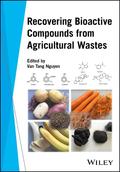Recovering Bioactive Compounds from Agricultural Wastes

1. Edition September 2017
280 Pages, Hardcover
Wiley & Sons Ltd
A guide to the extraction, isolation and purification of bioactive compounds from agricultural wastes, and their applications
Recovering Bioactive Compounds from Agricultural Wastes offers a guide to the many uses of agricultural wastes from the production of major food types including tea, coffee, cacao, cashew, fruit and vegetables, wine, edible oils, sugar, starch and more. Written by a noted expert in the field, the text explores the various methods for extraction, isolation and purification of bioactive compounds from agricultural wastes. The author also makes recommendations concerning the most effective applications of bioactive compounds and discusses the economics and market for recovered bioactive compounds.
Recent studies reveal that bioactive compounds have been directly linked to biological activity such as antioxidant, anticancer, antidiabetic, anti-cardiovascular capacities, etc. In particular, agricultural wastes are considered as potential and inexpensive sources of bioactive compounds. Recovering Bioactive Compounds from Agricultural Wastes fills a gap in the literature by providing a text that explores this important topic and examines the:
* Sustainability of waste management and shows how to extract, isolate and purify bioactive compounds from agricultural wastes, and their most effective application
* Wide range of agricultural food produce that can be processed and the special techniques used for recovering the bioactive compounds from these sources
* Health applications of bioactive compounds that have been directly linked to pharmacological activities including antioxidant, anticancer, and more
Designed for use by researchers and producers in the agriculture, pharmaceuticals and nutraceuticals, Recovering Bioactive Compounds from Agricultural Wastes contains the knowledge, history and definition, classification and synthesis, and extraction techniques of bioactive compounds.
1.1 Introduction 3
1.2 Potential of agricultural wastes 4
1.3 Uses of agricultural wastes and recovered bioactive compounds 23
1.4 Future perspectives of agricultural wastes and recovered bioactive compounds 28
1.5 Conclusions 29
References 29
Chapter 2 Bioactive compounds and extraction techniques 32
2.1 History and definition of bioactive compounds 35
2.2 Classification and synthesis of bioactive compounds 37
2.3 Extraction techniques of bioactive compounds 38
References 51
Chapter 3 Recovering bioactive compounds from tea, coffee, cacao and cashew wastes 64
3.1 Introduction 66
3.2 Recovering bioactive compounds from tea wastes 66
3.3 Recovering bioactive compounds from coffee wastes 72
3.4 Recovering bioactive compounds from cacao wastes 78
3.5 Recovering bioactive compounds from cashew wastes 83
3.6 Conclusions 89
References 89
Chapter 4 Recovering bioactive compounds from fruit and vegetable wastes 97
4.1 Introduction 99
4.2 Resources of bioactive compounds from fruit and vegetable wastes 99
4.3 Recovering bioactive compounds from fruit and vegetable wastes 101
4.4 Conclusions 116
References 117
Chapter 5 Recovering bioactive compounds from wine wastes 125
5.1 Introduction 127
5.2 Recovering bioactive compounds from wine wastes 128
5.2.1. Polyphenols from wine wastes 128
5.2.2. Other bioactive compounds from wine wastes 146
5.3 Conclusions 149
References 149
Chapter 6 Recovering bioactive compounds from edible oil wastes 154
6.1 Introduction 156
6.2 Edible oil processing and by-products 158
6.3 Recovering bioactive compounds from edible oil wastes 162
6.4 Conclusions 185
References 186
Chapter 7 Recovering bioactive compounds from sugar wastes 194
7.1 Introduction 196
7.2 Chemical composition and functional properties of sugarcane 197
7.3 Cane sugar production and its by-products/wastes 201
7.4 Recovering bioactive compounds from cane sugar by-products/wastes 203
7.5 Conclusions 212
References 213
Chapter 8 Recovering bioactive compounds from starch wastes 216
8.1 Introduction 218
8.2 Recovering bioactive compounds from starch wastes 219
8.2.1. Bioactive compounds from potato wastes 219
8.2.2. Bioactive compounds from rice and wheat wastes 225
8.2.3. Bioactive compounds from other starch wastes 235
8.3 Conclusions 240
References 240
Chapter 9 Recovering bioactive compounds from other agricultural wastes 244
9.1 Introduction 246
9.2 Recovering bioactive compounds from pepper waste 247
9.3 Recovering bioactive compounds from onion waste 259
9.4 Recovering bioactive compounds from cotton waste 265
9.5 Conclusion 270
References 271
Chapter 10 The economics and market of recovered bioactive compounds from agricultural
wastes 278
10.1 Introduction 280
10.2 Economic analysis of recovered bioactive compounds 281
10.3 Market analysis of recovered bioactive compounds 302
10.4 Conclusions 308
References 308
Index 311
Van Tang Nguyen is a Demonstrator at the School of Environmental and Life Sciences, University of Newcastle, Australia, and a Lecturer at the Faculty of Food Technology, Nha Trang University, Vietnam.


